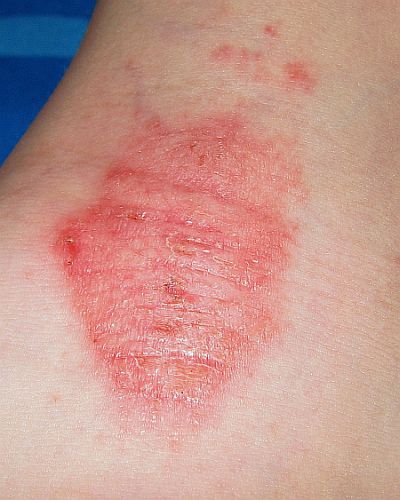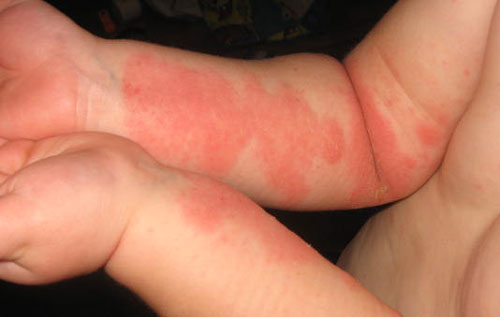Eczema is much less frequent in adolescence than in the first years of childhood. In teen-agers it usually causes a thickening, dryness, and redness of the skin. Itching, and at times pain, may accompany the rash. At this age, eczema is most frequently found in the folds of the elbows and knees and on the wrists. Another common location is the back of the neck and ears.
Eczema may bring scaling of the skin. At times there is marked splitting of the skin and sometimes blisters appear, filled with clear fluid or pus.
The cause of eczema is usually an allergy. Though in infancy, the allergens (allergy causers) are nearly always foods, in later years the eczema is just as likely to be a reaction to wool, nylon, or other materials. Reactions to various plants can also cause the rash. The reactions may be from touching the plants or from inhaling their pollens.
Edna has severe eczema. She has had to give her dog away and must avoid visiting homes where cats or birds are kept as pets, as she is allergic to these animals.
She cannot eat fish, nuts, or chocolate. If she does eat a little of these forbidden foods, she may break out with a worse rash. Then she takes antihistamines which counteract the body’s response to allergens.
Fairly frequently she has to take penicillin to fight the infection that attacks her sensitive skin.
When her rash gets worse, and she knows it is not allergy or infection that has caused the flare-up, she has learned to look for an emotional problem that she may be trying to ignore. One time she realized that the strain of school exams was making her scratch more. On another occasion it was a quarrel with her father which had made her feel guilty.
The emotions can play an important role in eczema. If a person is anxious or tense, he is more likely to scratch and pick at the lesions. This can lead to trouble from secondary bacterial infections, or just from the mechanical irritation and injury to the skin. When the eczema has a nervous or emotional root, the medical term for it is neurodermatitis.
Allergic reactions of the skin can be so brief that they last only a few minutes. They can be so prolonged that they last for months or years.
The briefer type usually are hives, also known as wheals or welts. Hives may be small white or yellow-centered blisters with some redness surrounding them. Flea bites and mosquito bites are examples of this kind of hives. Giant hives, or urticaria, can be so large that one may cover most of the body.
Besides insect stings, other causes of hives are the allergy-producing materials-foods, plants, and clothing. Strawberries and other fresh fruits, particularly citruses (oranges, lemons, and grapefruits) are known to bring on hives. Chocolate, wheat, milk, eggs, nuts, and fish are other fairly frequent food allergens. In some cases any food may cause trouble.
Hives may appear and then vanish so rapidly that treatment is not necessary. Sometimes they keep recurring until the allergen is discovered and removed. Physicians have found that treatment with antihistamines may be helpful. At times an injection of adrenalin gives relief. In severe instances cortisone or a similar adrenal-hormone like drug may be used.
Some of the severest cases of skin reactions, occasionally combined with joint pain and swelling or with asthmatic attacks, are caused by allergic reactions to certain medications. Penicillin, which has been of inestimable benefit to mankind since its first medical use in World War II, has occasionally caused much anguish because of an allergic reaction in certain persons.
Allergic skin reactions may show up as marked swellings of small parts of the body. Localized swellings are most usually seen on a lip (“fat lip”) or an eyelid. They can also be seen on other places on the face and on the hands, feet, arms, or legs.
Treatment is the same as for hives. There is one caution with these cases of swelling, called angioneurotic edema. In rare instances the swelling affects the back of the tongue or the inner throat. When this happens, it may be a real medical emergency because the swelling may shut off the breathing space. The patient should be rushed to an emergency hospital or doctor’s office, where injections may be lifesaving. A tracheotomy (putting a hole into the windpipe through an incision in the front of the neck) may be needed if breathing is fully blocked.




